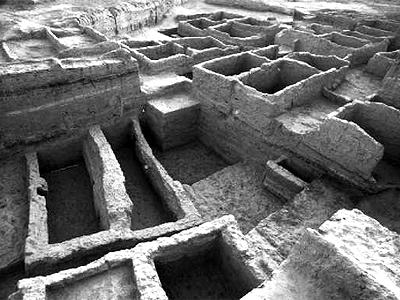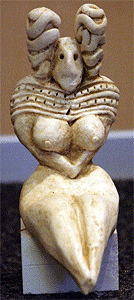
Mehrgarh (partial excavation)



Precursor to Indus Valley Civilization; this site was continuously occupied from 8000 BCE through 2500 BCE (!), built by the oldest Neolithic culture of the Indian subcontinent, with the earliest evidence of herding and farming. From the most ancient times humans and their ancestors have traveled between the Iranian highlands and the Indus River basin passing through the Bolan Pass. Hunters, pastoralists, traders, invaders and others have ventured into the land of the Indus, over thousands of years. The city of Mehrgarh, at the lower end of Bolan Pass, is the site of the dawn of India's first civilisation - the Indus Valley or Harappan Civilisation. The archaeological remains of Mehrgarh are located on the west bank of the River Bolan, several kilometers southwest of present-day town of Sibi, Pakistan. Before the discovery of Mehrgarh by the French archaeological team, led by Jean-Francoise and Catherine Jarrige, in 1974, scholars speculated that Harrappan ancestors were either Mesopotamian or Elamite from the West. When the French discovered Mehrgarh, it was known for the first time that settled agrarian civilization in the subcontinent dated back almost 8500 years. Previous excavations in India had shown the presence of Homo erectus to at least 1.2 million years ago, and a Middle Paleolithic Phase dating from 380,000 years ago, the earliest such sites outside of Africa. Rice was cultivated here in the 8th to 7th millennium BCE. In the site excavation model shown, the earliest buildings, houses, are rendered in the lightest color, and the later building, large square blocks with interior wall grids, are storehouses and grain silos.
Elevation is c. 146 meters (480 feet) above sea level.
Materials: mud brick walls; wood beams and rafters; mud/clay roofs (with entrance openings).
Data for this CG model:
1. Jarrige, Jean-Francois, 2006. Mehrgarh Neolithic, Paper presented in the International Seminar on the "First Farmers in Global Perspective', Lucknow, India, 18-20 January, 2006
( http://archaeology.up.nic.in/doc/mn_jfj.pdf ).
2. Coningham, Robin, 2015. The Cambridge World History, Part Two - The Indus Valley Tradition (c.6500–1900 BCE), Cambridge University Press.
https://www.cambridge.org/core/books/archaeology-of-south-asia/indus-valley-tradition-c65001900-bce/75DA428D28B2C45658729A50AC509163
3. Dalal, Kurush, 2020; Mehrgarh & The Dawn of Civilization (8000 BCE - 2500 BCE), in Live History India, February 8, 2020.
https://www.livehistoryindia.com/history-of-india-2000-years/2020/02/08/mehrgarh-the-dawn-of-a-civilisation-8000-bce-2500-bce






